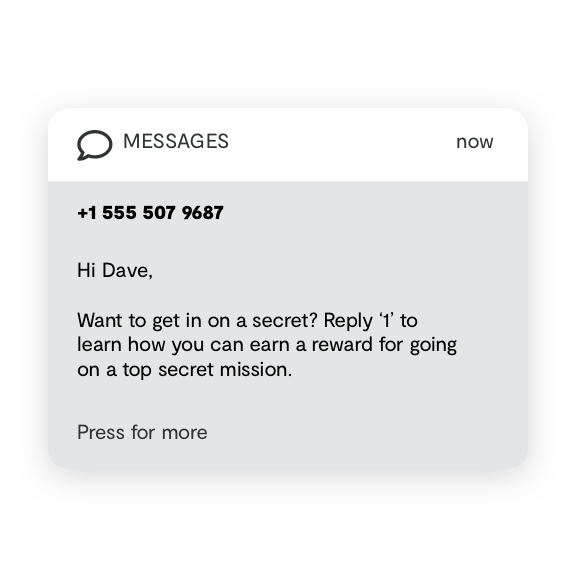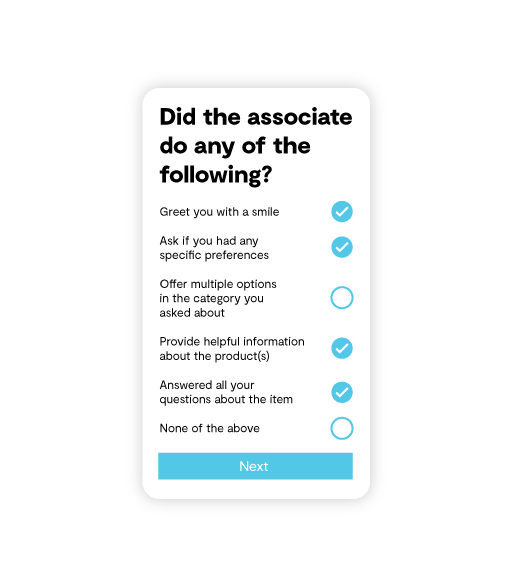How well are you actually listening to your customers? Do you know when new complaints arise and when previous issues resurface?
This why so many retail brands rely on customer satisfaction survey questions to identify problems, reevaluate service priorities, and adapt to changing customer demands. Simply put, customer feedback is crucial for brand health.
Survey design can make or break the entire effort. The questions you ask, and how and when you ask them, determine both the value of the data and the amount of brand equity you win or lose.
A well-crafted, well-timed customer satisfaction survey deepens your customers’ emotional investment by motivating them to respond and rewarding them for doing so. So how do you build and deploy a survey that elicits the reaction you want and the insights you need?
Here’s our list of 35 sample customer satisfaction survey questions to get you started and how to go about asking the questions in the first place:
Click on the jump links to skip ahead.
- Fine Line Questions
- Tints & Shades Questions
- In-Store Customer Service Questions
- In-Store Shopping Experience Questions
- Retention Questions
- Broad Stroke Questions
Mastering the Art of the Customer Satisfaction Survey: 3 Key Elements
A customer satisfaction survey is like a blank canvas. The richer the detail, the better the result. Your customers should be able to express themselves using a variety of techniques.
Fine Line Questions
Pointed, close-ended questions create a profile of the shopper and provide context for other survey responses.
- What is your age/gender?
- How long have you been a [brand] customer?
- What was the total purchase amount on your receipt today?
- How often do you visit this store?
- Did you visit the store based on a promotion or sale?
- Based on this experience, would you return to this store for [product/service]?
- Would you like someone to contact you?
Tints & Shades Questions
Scale questions are designed to register how positively or negatively your customer reacted to the overall shopping experience and to various touchpoints along the way. While a neutral response might indicate the need for strategic adjustments, responses at either end of the spectrum reveal the most impactful moments in the customer journey.
It’s important to keep these questions as simple as possible for your customers. This is essential for those who struggle to rate experiences on the classic 1-10 scale. A scale of 1-4 makes surveys less burdensome and produces more reliable results.
In-Store Customer Service Questions
Example 1: Coffee shop customers might be asked to rate the particulars below via degree of satisfaction: (1: Completely dissatisfied and 4: Extremely satisfied).
- How do you feel about your overall experience at this store?
- Was the coffee warm enough?
- How well was the coffee counter/area stocked?
- How did your beverage taste?
- Was your food order accurate?
- Were the restrooms generally clean?
In-Store Shopping Experience Questions
Example 2: An apparel retailer might ask the following questions using a different scale: (1: Completely disagree and 4: Completely agree).
- Were you made to feel welcome during your visit (greeted and/or thanked by one or more associates)?
- Were the outfitted mannequins helpful in building an ensemble?
- Were the items appropriately priced?
- Did one or more associates offer to help you?
- Were the associates friendly?
- Were the associates knowledgeable?
- Was the merchandise high quality?
- Were the items you looked for in stock?
- Were the items you looked for easy to find?
- Did the store have a wide selection?
- Was it easy to find items in your size?
- Was the store visually appealing?
- Was the wait time at checkout reasonable?
- Did the cashier process the transaction quickly and effectively?
- Did the store have a reasonable return and exchange policy?
Retention Questions
Example 3: These reflective questions are designed to gauge probability of a future action: (1: Not at all likely and 4: Very likely).
- How likely are you to return to this store?
- How likely are you to recommend this store to others?
Broad Stroke Questions
Open-ended questions, which can be triggered by negative feedback and/or appear at the end of the survey, give customers the floor. Responses often yield surprising insights.
This upends long-held assumptions about what customers want and how well the brand delivers. It occasionally works as a wake-up call as every brand needs to stay aligned with its customer base.
- Why did you choose this rating?
- If the item you were looking for wasn’t available, what item(s) would you like to see?
- What did you like best about shopping at our store?
- How could we have made this experience better for you?
- What suggestions do you have for improving the shopping experience?
Make Your Csat Survey Timely & Rewarding
To know the touchpoints performing best and what might be sabotaging sales, it’s important to ask the right questions. It’s also necessary to ask while the experience is fresh in the customer’s mind.
If a survey arrives days (even hours) after an in-store visit, they’re likely to forget key details or lose interest in sharing them. This is also true when customers are asked to log in to complete a survey.
Most survey responses will come from customers who are either extremely satisfied or extremely dissatisfied, thus skewing the results. And you’ll never hear from people who left the store without buying.

The most enticing, effective way to survey your customers is to enlist them as secret shoppers. Give them the means to answer questions about the customer journey in real time, regardless of whether they make a purchase.
They can detail their visit in an objective way while offering their subjective take on what was good, bad and unimportant. With this objective/subjective data mix, you’ll know at once how well brand protocols are being followed, which protocols matter and what’s working against you.
How to Reward Shoppers & Build Brand Equity
Unlike traditional CSATs, which are a chore to complete (hence the typical 2% response rate), real-time in-store CSATs make the shopping experience fun. Your “secret agent” customers become agents of change with an important purpose: contributing to a better brand experience going forward.

The moment you invite a customer to go undercover, you’ll inspire a degree of loyalty most brands can only hope to earn. Forget costly mystery shopping and low-response CSATs.
Managing the in-store customer experience has never been easier. Use Journey IQ to uncover actionable insights into your in-store experience.
Want to learn about our innovative platform leading brands use to monitor and improve their stores and drive foot traffic and loyalty? Request a demo of Journey IQ today!





